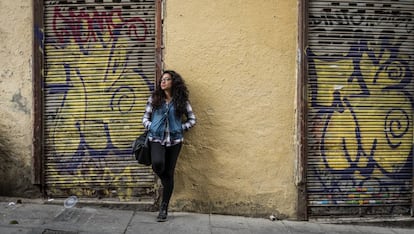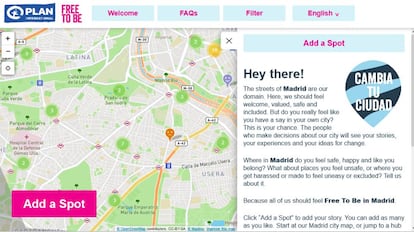Madrid gets a map that lets women warn others of harassment hot-spots
Online initiative enables female users to flag up places where they felt uncomfortable or threatened in a bid to make the city a safer place

On Doctor Esquerdo street, in the Madrid neighborhood of Pacífico, a young woman was accosted by a man who wanted to take her for a drive. When she refused, he groped her and left. And on a summer night at around 10pm, a man started running after a young woman on Caracas street, in the neighborhood of Almagro, screaming “Come here, blondie!” as he chased her.
These are two of the more than 100 stories of harassment collected on a website called Free to be, where women aged 15 through 24 can use a map of the city to point out spots where they feel safe or unsafe, and share their stories.
The project was designed by the humanitarian organization Plan International in partnership with CrowdSpot and Monash University’s XYX Lab. Before coming to Madrid, it was rolled out in Delhi and Kampala (India), in Lima (Peru) and in Sydney (Australia).

Even though Madrid is considered to be one of the safest cities in the world, young women continue to endure lewd comments, intimidating looks and other forms of street harassment.
Around 10% of the Spanish capital’s more than three million residents are 14- to 25-year-old females, the social group most likely to suffer this form of abuse, according to National Statistics Institute (INE) figures.
There is no need to download an application to participate in the Madrid Free to Be project. Contributions are anonymous and users are asked to answer a set of questions regarding the nature of their experience, the time and exact location where it happened, what they did afterwards, and how they think that safety could be improved at that particular location.
Although Madrid is deemed one of the safest cities in the world, young women continue to endure lewd comments, intimidating looks and other forms of street harassment
Madrid is not the first city to adopt such a study. There was a similar experience in Delhi as part of the Safe Cities program run by Plan International in partnership with UN Women and UN Habitat, and also in Cairo, although in those cases women used a physical map that they dotted with thumbtacks. The Spanish initiative was launched a little over a week ago in digital format thanks to support from the map creation website CrowdSpot and Australia’s Monash University.
Organizers want young women themselves to be the ones to propose changes to their city that will make them feel safer in it. Starting in October, city authorities will get involved when the non-profit presents a report with the conclusions of the six-week study, said Emilia Sánchez, of the Spanish branch of Plan International.
For now, only spots located within the M-30 ring road may be flagged up, as requested by the Australian university in order to facilitate data analysis.
English version by Susana Urra.
Tu suscripción se está usando en otro dispositivo
¿Quieres añadir otro usuario a tu suscripción?
Si continúas leyendo en este dispositivo, no se podrá leer en el otro.
FlechaTu suscripción se está usando en otro dispositivo y solo puedes acceder a EL PAÍS desde un dispositivo a la vez.
Si quieres compartir tu cuenta, cambia tu suscripción a la modalidad Premium, así podrás añadir otro usuario. Cada uno accederá con su propia cuenta de email, lo que os permitirá personalizar vuestra experiencia en EL PAÍS.
¿Tienes una suscripción de empresa? Accede aquí para contratar más cuentas.
En el caso de no saber quién está usando tu cuenta, te recomendamos cambiar tu contraseña aquí.
Si decides continuar compartiendo tu cuenta, este mensaje se mostrará en tu dispositivo y en el de la otra persona que está usando tu cuenta de forma indefinida, afectando a tu experiencia de lectura. Puedes consultar aquí los términos y condiciones de la suscripción digital.
More information
Archived In
Últimas noticias
The new victims of the Republican war on Obamacare: Millions hit by soaring health insurance premiums
A country divided on migrant rights: Some US states expand protections while others restrict them
Venezuela authorizes the release of another 87 political prisoners
There is as much life left to discover on planet Earth as that which is already known
Most viewed
- David King, chemist: ‘There are scientists studying how to cool the planet; nobody should stop these experiments from happening’
- Reinhard Genzel, Nobel laureate in physics: ‘One-minute videos will never give you the truth’
- Oona Chaplin: ‘I told James Cameron that I was living in a treehouse and starting a permaculture project with a friend’
- Sinaloa Cartel war is taking its toll on Los Chapitos
- The Interoceanic Train, the Mexican alternative to the Panama Canal










































